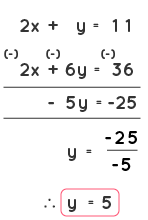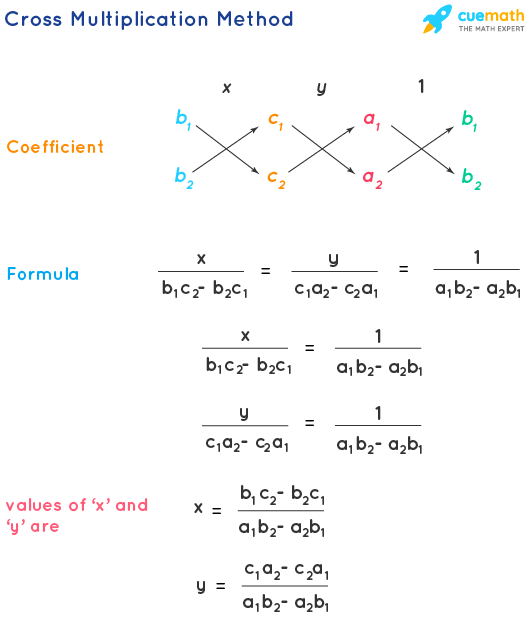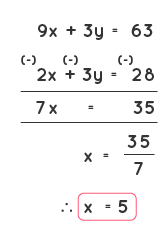Solving Linear Equations
Solving linear equations means finding the value of the variable(s) given in the linear equations. A linear equation is a combination of an algebraic expression and an equal to (=) symbol. It has a degree of 1 or it can be called a first-degree equation. For example, x + y = 4 is a linear equation. Sometimes, we may have to find the values of variables involved in a linear equation. When we are given two or more such linear equations, we can find the values of each variable by solving linear equations. There are a few methods to solve linear equations. Let us discuss each of these methods in detail.
Solving Linear Equations in One Variable
A linear equation in one variable is an equation of degree one and has only one variable term. It is of the form 'ax+b = 0', where 'a' is a non zero number and 'x' is a variable. By solving linear equations in one variable, we get only one solution for the given variable. An example for this is 3x - 6 = 0. The variable 'x' has only one solution, which is calculated as
3x - 6 = 0
3x = 6
x = 6/3
x = 2
For solving linear equations with one variable, simplify the equation such that all the variable terms are brought to one side and the constant value is brought to the other side. If there are any fractional terms then find the LCM (Least Common Multiple) and simplify them such that the variable terms are on one side and the constant terms are on the other side. Let us work out a small example to understand this.
4x + 8 = 8x - 10. To find the value of 'x', let us simplify and bring the 'x' terms to one side and the constant terms to another side.
4x - 8x = -10 - 8
-4x = -18
4x = 18
x = 18/4
On simplifying, we get x = 9/2.
Solving Linear Equations by Substitution Method
The substitution method is one of the methods of solving linear equations. In the substitution method, we rearrange the equation such that one of the values is substituted in the second equation. Now that we are left with an equation that has only one variable, we can solve it and find the value of that variable. In the two given equations, any equation can be taken and the value of a variable can be found and substituted in another equation. For solving linear equations using the substitution method, follow the steps mentioned below. Let us understand this with an example of solving the following system of linear equations.
x + y = 6 --------------(1)
2x + 4y = 20 -----------(2)
Step 1: Find the value of one of the variables using any one of the equations. In this case, let us find the value of 'x' from equation (1).
x + y = 6 ---------(1)
x = 6 - y
Step 2: Substitute the value of the variable found in step 1 in the second linear equation. Now, let us substitute the value of 'x' in the second equation 2x + 4y = 20.
x = 6 - y
Substituting the value of 'x' in 2x + 4y = 20, we get,
2(6 - y) + 4y = 20
12 - 2y + 4y = 20
12 + 2y = 20
2y = 20 - 12
2y = 8
y = 8/2
y = 4
Step 3: Now substitute the value of 'y' in either equation (1) or (2). Let us substitute the value of 'y' in equation (1).
x + y = 6
x + 4 = 6
x = 6 - 4
x = 2
Therefore, by substitution method, the linear equations are solved, and the value of x is 2 and y is 4.
Solving Linear Equations by Elimination Method
The elimination method is another way to solve a system of linear equations. Here we make an attempt to multiply either the 'x' variable term or the 'y' variable term with a constant value such that either the 'x' variable terms or the 'y' variable terms cancel out and gives us the value of the other variable. Let us understand the steps of solving linear equations by elimination method. Consider the given linear equations:
2x + y = 11 ----------- (1)
x + 3y = 18 ---------- (2)
Step 1: Check whether the terms are arranged in a way such that the 'x' term is followed by a 'y' term and an equal to sign and after the equal to sign the constant term should be present. The given set of linear equations are already arranged in the correct way which is ax+by=c or ax+by-c=0.
Step 2: The next step is to multiply either one or both the equations by a constant value such that it will make either the 'x' terms or the 'y' terms cancel out which would help us find the value of the other variable. Now in equation (2), let us multiply every term by the number 2 to make the coefficients of x the same in both the equations.
x + 3y = 18 ---------- (2)
Multiplying all the terms in equation (2) by 2, we get,
2(x) + 2(3y) = 2(18). Now equation (2) becomes,
2x + 6y = 36 -----------(2)
Step 3: The next step is to simplify these two equations by adding or subtracting them (whichever operation is required to cancel the x terms). Now, by subtracting the two equations, we can cancel out the 'x' terms in both equations.

Therefore, y = 5.
Step 4: Using the value obtained in step 3, find out the value of another variable by substituting the value in any of the equations. Let us substitute the value of 'y' in equation (1). We get,
2x + y = 11
2x + 5 = 11
2x = 11 - 5
2x = 6
x = 6/2
x = 3
Therefore, by solving linear equations, we get the value of x = 3 and y = 5.
Graphical Method of Solving Linear Equations
Another method for solving linear equations is by using the graph. When we are given a system of linear equations, we graph both the equations by finding values for 'y' for different values of 'x' in the coordinate system. Once it is done, we find the point of intersection of these two lines. The (x,y) values at the point of intersection give the solution for these linear equations. Let us take two linear equations and solve them using the graphical method.
x + y = 8 -------(1)
y = x + 2 --------(2)
Let us take some values for 'x' and find the values for 'y' for the equation x + y = 8. This can also be rewritten as y = 8 - x.
| x | 0 | 1 | 2 | 3 | 4 |
| y | 8 | 7 | 6 | 5 | 4 |
Let us take some values for 'x' and find the values for 'y' in the equation y = x + 2.
| x | 0 | 1 | 2 | 3 | 4 |
| y | 2 | 3 | 4 | 5 | 6 |
Plotting these points on the coordinate plane, we get a graph like this.

Now, we find the point of intersection of these lines to find the values of 'x' and 'y'. The two lines intersect at the point (3,5). Therefore, x = 3 and y = 5 by using the graphical method of solving linear equations.
This method is also used to find the optimal solution of linear programming problems. Let us look at one more method of solving linear equations, which is the cross multiplication method.
Cross Multiplication Method of Solving Linear Equations
The cross multiplication method enables us to solve linear equations by picking the coefficients of all the terms ('x' , 'y' and the constant terms) in the format shown below and apply the formula for finding the values of 'x' and 'y'.

Topics Related to Solving Linear Equations
Check the given articles related to solving linear equations.
Solving Linear Equations Examples
-
Example 1: Solve the following linear equations by the substitution method.
3x + y = 13 --------- (1)
2x + 3y = 18 -------- (2)Solution:
By using the substitution method of solving linear equations, let us take the first equation and find the value of 'y' and substitute it in the second equation.
From equation (1), y = 13-3x.
Now, substituting the value of 'y' in equation (2), we get,
2x + 3 (13 - 3x) = 18
2x + 39 - 9x = 18
-7x + 39 = 18
-7x = 18 - 39
-7x = -21
x = -21/-7
x = 3
Now, let us substitute the value of 'x = 3' in equation (1) and find the value of 'y'.
3x + y = 13 ------- (1)
3(3) + y = 13
9 + y = 13
y = 13 - 9
y = 4Therefore, by the substitution method, the value of x is 3 and y is 4.
-
Example 2: Using the elimination method of solving linear equations find the values of 'x' and 'y'.
3x + y = 21 ------ (1)
2x + 3y = 28 -------- (2)Solution:
By using the elimination method, let us make the 'y' variable to be the same in both the equations (1) and (2). To do this let us multiply all the terms of the first equation by 3. Therefore equation (1) becomes,
3(3x) + 3(y) = 63
9x + 3y = 63 ---------- (3)
The second equation is,
2x + 3y = 28
Now let us cancel the 'y' terms and find the value of 'x' by subtracting equation (2) from equation (3). This is done by changing the signs of all the terms in equation (2).
Substituting the value of x = 5 in equation (1) we get,
3x + y = 21 --------(1)
3(5) + y = 21
15 + y = 21
y = 21 - 15
y = 6
Therefore, by the elimination method, the value of x is 5 and y is 6. -
Example 3: Using the cross multiplication method of solving linear equations, solve the following equations.
x + 2y - 16 = 0 --------- (1)
4x - y - 10 = 0 ---------- (2)Solution:
Compare the given equation with \(a_{1}\)x + \(b_{1}\)y + \(c_{1}\) = 0, and \(a_{2}\)x+\(b_{2}\)y+\(c_{2}\) = 0. From the given equations,
\(a_{1}\) = 1, \(a_{2}\) = 4, \(b_{1}\) = 2, \(b_{2}\) = -1, \(c_{1}\) = -16, and \(c_{2}\) = -10.
By cross multiplication method,
x = \(b_{1}\)\(c_{2}\) - \(b_{2}\)\(c_{1}\)/\(a_{1}\)\(b_{2}\) - \(a_{2}\)\(b_{1}\)
y = \(c_{1}\)\(a_{2}\) - \(c_{2}\)\(a_{1}\) / \(a_{1}\)\(b_{2}\) - \(a_{2}\)\(b_{1}\)Substituting the values in the formula we get,
x = ((2)(-10)) - ((-1)(-16)) / ((1)(-1)) - ((4)(2))
x = (-20-16)/(-1-8)
x = -36/-9
x = 36/9
x = 4
y = ((-16)(4)) - ((-10)(1)) / ((1)(-1)) - ((4)(2))
y = (-64 + 10) / (-1 - 8)
y = -54 / -9
y = 54/9
y = 6
Therefore, by the cross multiplication method, the value of x is 4 and y is 6.

FAQs on Solving Linear Equations
What does it Mean by Solving Linear Equations?
An equation that has a degree of 1 is called a linear equation. We can have one variable linear equations, two-variable linear equations, linear equations with three variables, and more depending on the number of variables in it. Solving linear equations means finding the values of all the variables present in the equation. This can be done by substitution method, elimination method, graphical method, and the cross multiplication method. All these methods are different ways of finding the values of the variables.
How to Use the Substitution Method for Solving Linear Equations?
The substitution method of solving equations states that for a given system of linear equations, find the value of either 'x' or 'y' from any of the given equations and then substitute the value found of 'x' or 'y' in another equation so that the other unknown value can be found.
How to Use the Elimination Method for Solving Linear Equations?
In the elimination method of solving linear equations, we multiply a constant or a number with one equation or both the equations such that either the 'x' terms or the 'y' terms are the same. Then we cancel out the same term in both the equations by either adding or subtracting them and find the value of one variable (either 'x' or 'y'). After finding one of the values, we substitute the value in one of the equations and find the other unknown value.
What is the Graphical Method of Solving Linear Equations?
In the graphical method of solving linear equations, we find the value of 'y' from the given equations by putting the values of x as 0, 1, 2, 3, and so on, and plot a graph in the coordinate system for the line for various values of 'x' for both the system of linear equations. We will see that these two lines intersect at a point. This point is the solution for the given system of linear equations. If there is no intersection point between two lines, then we consider them as parallel lines, and if we found that both the lines lie on each other, those are known as coincident lines and have infinitely many solutions.
What are the Steps of Solving Linear Equations that has One Variable?
A linear equation is an equation with degree 1. To solve a linear equation that has one variable we bring the variable to one side and the constant value to the other side. Then, a non-zero number may be added, subtracted, multiplied, or divided on both sides of the equation. For example, a linear equation with one variable will be of the form 'x - 4 = 2'. To find the value of 'x', we add the constant value '4' to both sides of the equation. Therefore, the value of 'x = 6'.
What are the Steps of Solving Linear Equations having Three Variables?
To solve a system of linear equations that has three variables, we take any two equations and variables. We then take another pair of linear equations and also solve for the same variable. Now that, we have two linear equations with two variables, we can use the substitution method or elimination method, or any other method to solve the values of two unknown variables. After finding these two variables, we substitute them in any of the three equations to find the third unknown variable.
What are the 4 Methods of Solving Linear Equations?
The methods for solving linear equations are given below:
- Substitution method
- Elimination method
- Cross multiplication method
- Graphical method
visual curriculum